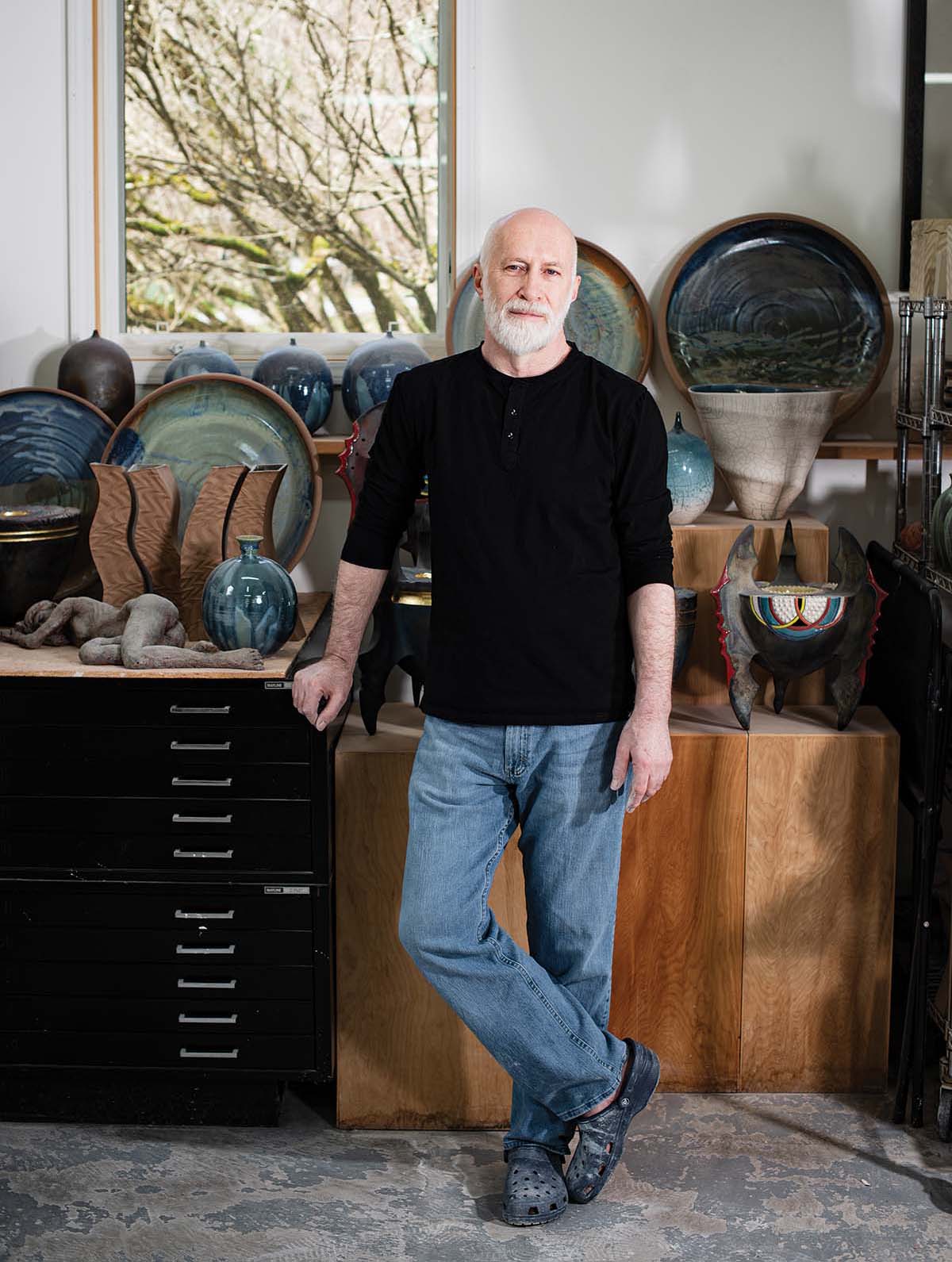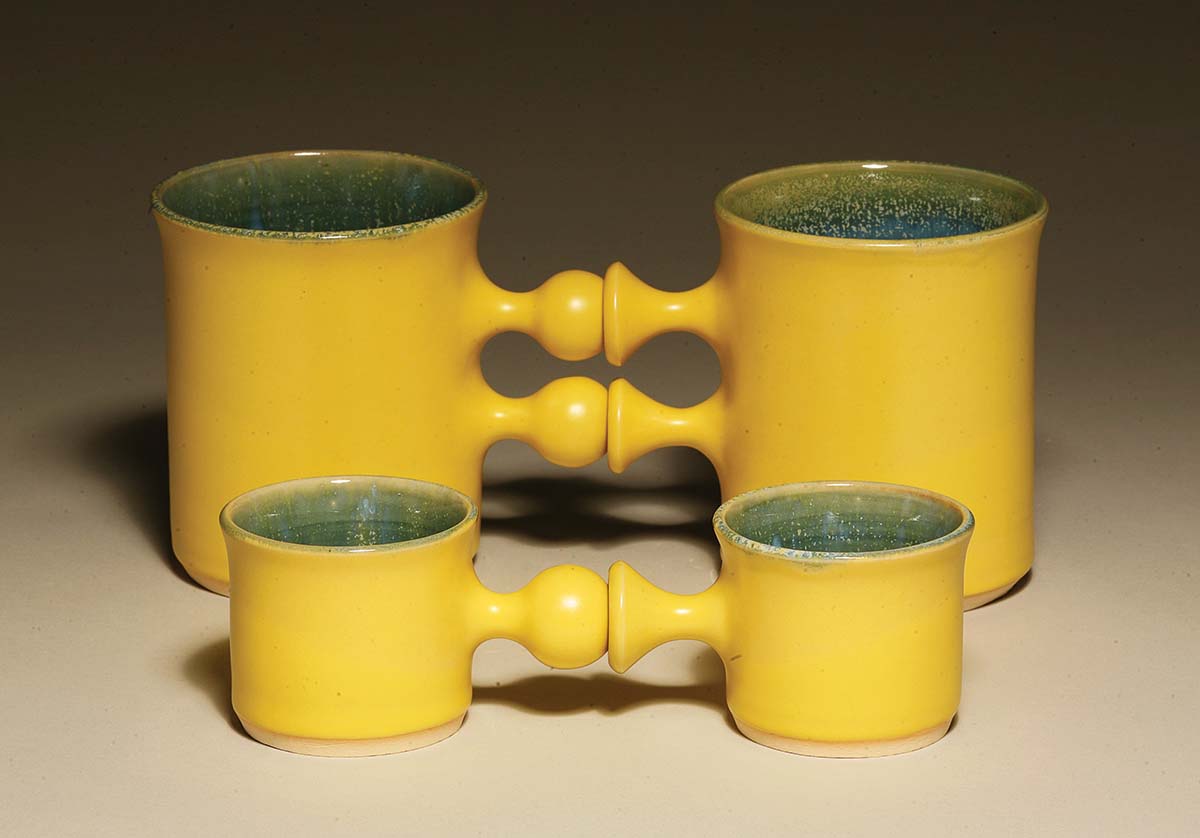
Leonid Siveriver’s Weaverville studio is more like a gallery. Jazz wafts through the air, and the sheer diversity of shapes, colors, and objects — abstract, representational, and purely utilitarian — requires more than a moment to absorb. The work space he shares with his wife Amy Medford, a sculptor and jewelry designer, reveals that he’s as prolific as he is inspired. “I’m heavily influenced by the human form and ancient cultures,” says Siveriver, surrounded by his multimedia sculptures of faces and otherworldly creatures, decorative Raku vessels (some of them dubbed altars), and luminous stone tableware.
The multilingual Siveriver is a citizen of the world. At 10, he matriculated at a children’s art school in his home country of Ukraine. When he was 14, his family immigrated to Jerusalem, where he later served three years in the military, like all young Israelis. He fell hard for ceramics, by accident: “I missed all the entry exams into art school except for ceramics and jewelry. I started out in jewelry but quickly knew it wasn’t for me. I switched to ceramics and was blown away by watching my teachers work on the pottery wheel. I loved every second of being there,” he says.
After earning his BFA from Jerusalem’s Bezalel Academy of Art and Design, Siveriver headed to Pietrasanta, Italy, to learn marble carving and bronze casting. Siveriver and Medford met as students at his next stop, the renowned Seward Johnson Atelier, a center devoted to sculpture education and appreciation in New Jersey.
Siveriver’s stoneware is atypical when compared with other regional artists’ work. There’s nary a muted earth tone in sight: He favors bright, happy yellow; deep indigo; and a range of greens from seafoam to pine. The artist initially resisted making mugs because he dreaded working small, but couldn’t refuse Medford’s eventual request for two. “I never thought I’d enjoy designing them,” he relates, “but every week I’d come up with five prototypes. Through experimentation, my ‘fit-together’ mugs were born.”
Each set includes a mug with a handle whose recessed edge is custom-designed to fit the other mug’s handle detail: a perfect sphere. Siveriver also fashions low, stout pairs with square handles that allow sippers to hold them via circles cut directly out of their centers.

The way he improvs with shape and line is best exemplified in his square, oblong, and triangular plates. Their surfaces are infused with urgent zigzag patterns, a technique he discovered by chance when he used a fine wire, usually reserved for cutting into clay, to stamp it.
The sculptor’s tulip-inspired nesting-bowl sets are poetic and space-saving, with both jagged and gently scalloped lips. When nesting, they look serenely symmetrical, like the traditional Matryoshka dolls of his homeland. Curvaceous mugs and pitchers abound, while certain sugar bowls and vessels are topped with lids that come to points, similar to the onion domes common in Russian architecture. Teapots lean toward the whimsical; some have triads of ball feet, others have flat bottoms and handles that mimic artfully rendered brass knuckles.
Siveriver’s sensual pitchers have womanly shapes and waterfall-like glaze patterns; his platters feature perfectly centered spiral lines overlaid with color splashes that echo mountain vistas. The curved bud vases he crafts also fit together, include angular and wavy patterns, and seem to come alive and read as figures. His collections recall the Midcentury minimalist genius of artist-designers like Russel Wright and Eva Zeisel, but they’re also futuristic in a highly organic sense.
The artist believes in the importance of marrying creativity with technical agility, which takes years to master: “You can have great ideas, but if you don’t have the technical skills to execute them, they remain ideas.” He says he never tires of the excitement of the creative process, but he he can get impatient, especially while waiting to open the kiln. “You never know what’s going to happen when you open that door — it can make you smile or gasp. Either way, it always inspires me to experiment further.”
For more information about Leonid Siveriver, see siveriverceramics.com.
